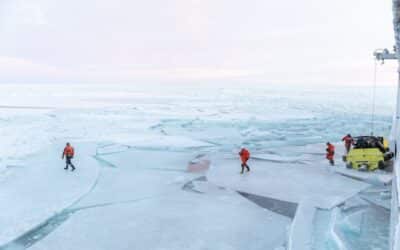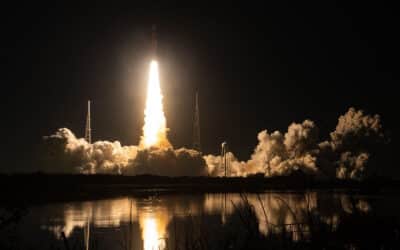Photo Credit: Alberta Newsroom
By Anja Chalmin
The third part of the report presents new developments, projects and funding programmes for the geoengineering field of Carbon Capture and Storage (CCS).
More than 70 new Carbon Capture and Storage projects started in 2021 with more than half in the US and other new developments in CCS
The third part of the report presents new developments, projects and funding programmes for the geoengineering field of Carbon Capture and Storage (CCS).
Cabon Capture and Storage (CCS) refers to the capture of CO2 emissions from power plants or other industrial sources using a sorbent. The captured CO2 is liquefied and transported to a location where it is injected underground, e.g., into old oil and gas reservoirs or saline aquifers. Theoretically, it should be stored in such geological formations for the long term, but the captured CO2 could leak for many reasons, e.g., earthquakes or other underground movements. According to a report on CCS development published in October 2021 by the Global CCS Institute, there were more than 70 new CCS projects in 2021, about half of them in the United States. Developments in new and existing CCS projects are presented below.
Australia
The Australian government allowed Chevron to develop the Gorgon natural gas facility on Barrow Island on the condition that at least 80 % of the CO2 emissions released at the site would be captured and injected underground over a five-year period from July 2016. Natural gas started flowing in 2017, but the commissioning of the Gorgon CCS project was delayed several times due to extensive technical problems. The CCS project was commissioned in August 2019 with ~30 % of the intended CO2 capture, and with improved operations from March 2020. In January 2021, it was revealed that the CO2 injection system was clogged with sand and therefore not functioning. According to press reports, the CCS project has missed the 5-year target of 80 % by about 50 % – that equates to about 7.4 million tonnes of CO2. For this reason, Chevron and its project partners must now pay penalties in the form of carbon credits worth AU$ 180 million.
In June 2021, Santos and Eni announced a partnership to develop a CCS storage hub in the Bayu-Undan gas field in the Timor Sea off the coast of Timor-Leste. Santos and Eni intend to capture CO2 at their LNG terminal in Darwin, Northern Territory, which was commissioned in 2006 as a facility to manage the import and export of liquefied fossil gas. The captured CO2 will then be transported in liquefied form about 500 kilometres to the Bayu-Undan field for injection under the seabed. A timetable for the project is not yet available.
Although the Gorgon CCS project has not worked as planned to date and many other CCS projects around the world have failed, the Australian government made AU$ 250 million in funding available for CCS and CCUS projects in September 2021. The program aims to support the design and construction of carbon capture hubs, identify carbon storage sites and support research and commercialization of CO2 capture technologies.
Malaysia
Petronas, a Malaysian state-owned petroleum company, intends to develop a CCS project in the Kasawari gas field offshore Sarawak, Malaysia. The project plans to capture CO2 and inject it into a depleted gas field. The gas produced from the Kasawari gas field is sour gas, a fossil gas with large amounts of CO2 and significant amounts of hydrogen sulphide. Petronas plans to start gas production in 2023 and CO2 injection in 2025. To finance the CCS project, Petronas is offering CCS as a solution to other local industries such as power, cement, steel and chemicals. The project envisages the capture and injection of about four million tonnes of CO2 per year.
Canada
British Columbia-based Svante Inc. has been developing CO2 capture technology since 2007. The company develops CO2 filters made from solid adsorbent nanomaterials. Svante Inc has received more than US$175 million in funding from 2007 to 2021, including US$100 million in its 2021 funding round.
SaskPower’s Boundary Dam CCS project reported in 2021 that it had achieved four million tonnes of CO2 capture. The project hides the fact that the amount of CO2 captured is declining: The CCS project has been in operation since 2014. After four years of operation, the project had captured a total of 2.46 million tonnes of CO2, or 0.62 million tonnes per year. In 2021, after seven years of operation, the average value dropped to 0.57 million tonnes of CO2 per year. The cause of the deterioration seems to be technical problems, e.g., the CCS plant was not in operation from mid-July to mid-October 2021.
Shell’s Quest CCS project, near Edmonton in Alberta, Canada, was commissioned in 2015 and operates at the Shell-operated Scotford oilsand upgrader. In July 2021, Shell announced that the Polaris CCS would be built nearby. The Polaris project will be located at the Scotford refinery and chemicals plant, also operated by Shell. Shell intends to commission the Polaris project in two phases. In the first phase, CO2 will be captured at the Scotford refinery and chemicals plant; in the second phase, a larger CO2 hub will be built. The captured CO2 will be transported via a 12-kilometre pipeline to injections wells near Josephburg, Alberta, where it will be injected into the Basal Cambrian Sands, the same formation where CO2 from the Quest CCS facility is stored.
In 2021, the Oil Sands Pathways to Net Zero Initiative, a coalition of Canadian oil sands producers, announced the Pathways CCUS project. The proposed project aims to capture CO2 at more than 20 oil sands facilities and transport the captured CO2 via pipeline to an injection site near Cold Lake, Alberta, likely for enhanced oil recovery (EOR). EOR involves pumping compressed CO2 into ageing oil fields to extract otherwise inaccessible oil – which means greater oil production and CO2 emissions. The Pathways CCUS project aims to explore CC(U)S, as well as direct capture of CO2 from the air and other CO2 capture approaches. In the first phase, the initiative plans to build a CO2 capture network in the oil sands production region in northern Alberta. Later, the network will be available to other industries in the region. In the first project phase (2021-2023) the aim is to capture 22 million tonnes of CO2 per year. In the second project phase (2031-2040) the project plans to capture 47 million tonnes of CO2 per year, and in the third project phase (2041-2050) 68 million tonnes of CO2 per year.
In June 2021, Pembina Pipeline Corporation and TC Energy Corporation announced plans to jointly develop the Alberta Carbon Grid (ACG). ACG is a large-scale CCS system designed to capture, liquefy, transport and inject underground more than 20 million tonnes of CO2 per year. The project plans to serve multiple industries, such as oil sands, power generation and other industrial sources, and connect several regions in Alberta to the grid, including the Fort McMurray region, the Alberta Industrial Heartland and the Drayton Valley region. The captured and liquefied CO2 will be transported via pipelines for underground injection into the Basal Cambrian Sands formation near Fort Saskatchewan, northeast of Edmonton, Alberta. The project aims to be operational by 2025. In November 2021, the ACG announced its intention to promote collaboration with Pathways CCUS and Polaris CCS CO2 hubs, which have similar plans for Alberta.
USA
CO2 capture capacity at the Shute Creek gas processing plant near LaBarge, Wyoming, owned and operated by ExxonMobil, will be expanded from the current 7 million tonnes per year to 8 million tonnes per year. The expansion project is presently in design and permitting phase; a final investment decision is expected in 2022. At this project site the captured CO2 is compressed and transported by pipeline for EOR in several oil fields in Wyoming. Expanding CO2 capture capacity means more EOR activity, and that means more oil being produced and having an impact on the climate.
In April 2021, ExxonMobil proposed a CCS hub for the industrial area along the Houston Ship Channel, a region with petrochemical plants, power companies and heavy industry. ExxonMobil is asking government and industry to jointly raise US$100 billion to create CCS infrastructure at industrial facilities and transport the captured CO2 via pipelines to the Gulf of Mexico, where it would be injected into geological formations. According to press reports, the following companies have expressed interest in working with ExxonMobil: Calpine, Chevron, Dow, Ineos, Linde, LyondellBasell, Marathon Petroleum, NRG Energy, Phillips 66, and Valero. The project aims to inject 50 million tonnes of CO2 annually by 2030 and 100 million tonnes of CO2 by 2040. The exact location of the planned injections in the Gulf of Mexico is not yet publicly known.
In September 2021, Dakota Gasification announced plans to expand CO2 capture capacity at the lignite-fired Great Plains Synfuels Plant near Beulah, North Dakota. Dakota Gasification plans to increase the plant’s CO2 capture capacity from the current 3 tonnes (though actual capture is lower) to 3.5 tonnes. The reason for the planned expansion is the US federal 45Q tax credit, which provides a new revenue stream for power plants and other industrial facilities when CO2 is captured and used for EOR or injected underground. Dakota Gasification uses the captured CO2 for EOR activities, which means US$35 per tonne of CO2 captured.
Norway
In October 2021, Elkem announced plans to test CO2 capture technology at its plant in Rana, Norway. The plant produces ferrosilicon and micro-silica. The CO2 capture technology will be supplied by Aker Carbon Capture. In addition, Elkem has commissioned a feasibility study to assess the technical and economic feasibility of CO2 capture at its Norwegian plants.
In September 2021, the Northern Lights Project, conducted by Equinor, Shell and Total, and the transportation and storage part of the Longship CCS Project, opened its new office in Stavanger, Norway and announced growth plans. Longship plans to capture CO2 at Norcem’s cement plant in Brevik in Porsgrunn and at Fortum Varme’s waste incineration plant in Klemetsrud in Oslo. The captured CO2 will be liquefied and transported by ship (585 km, 700 km) from the two plants to an intermediate storage facility in Øygarden, near Equinor’s Kollsnes plant. From Øygarden, the CO2 will be piped to the sea via a pipeline about 100 kilometres long and injected into a depleted well in the Johansen formation (Norwegian sector of the North Sea, ~30 kilometres off the Norwegian mainland), 2,600 metres below the seabed. In September 2021, Northern Lights announced plans to increase the CO2 capture capacity to five million tonnes per year – with significant volumes of CO2 from across the European continent. Since September 2019, Northern Lights signed several preliminary memorandums of understanding (MoU) for the handling of the CO2 with potential industrial partners, among them Microsoft, HeidelbergCement AG and Arcelor Mittal. Another preliminary MoU was signed with Future Biogas in June 2021.
In addition to the great uncertainties associated with the underground storage of CO2, the climate-damaging additional oil production made possible by EOR, CCS is associated with many other risks and harmful practices.
[1] Gehr, D. (2021) ‘It’s gonna screw up everything’: Boone County farmers decry proposed carbon capture pipeline, published: October 5, 2021, in Ames Tribune, Source: https://eu.amestrib.com/story/news/2021/10/05/iowa-farmers-decry-proposed-carbon-sequestration-pipeline-boone-county-summit-carbon-solutions/5989461001/; Gehr, D (2021) ‘My family’s been through this 4 times’: Story County residents push back against carbon sequestration pipeline, published: September 14, 2021, in Ames Tribune, Source: https://eu.amestrib.com/story/news/2021/09/14/iowa-farmers-push-back-against-proposed-carbon-sequestration-pipeline/8263752002/; Sisk, A.R. (2021) Pipeline Would Store Carbon Dioxide Emissions From Ethanol, published: November 15, 2021, in U.S. News, by Associated Press, Source: https://www.usnews.com/news/best-states/north-dakota/articles/2021-11-15/pipeline-would-store-carbon-dioxide-emissions-from-ethanol; Clayton, C. (2021) Getting Access for Carbon Pipelines. Ethanol Producers See Carbon Pipeline as Boon, While Some Landowners Fear Farmland Damage, Yield Losses. Published: October 20, 2021, in Progressive Farmer, Source: https://www.dtnpf.com/agriculture/web/ag/news/business-inputs/article/2021/10/19/ethanol-producers-see-carbon-boon, Summers, N. (2021) Midwest Carbon Dioxide Pipelines – What We Know And The Questions That Remain, published: November 9, 2021, in Center for Rural Affairs, Source: https://www.cfra.org/blog/midwest-carbon-dioxide-pipelines-what-we-know-and-questions-remain



